|
About
Ragdolls
This page
is graphic intensive - please be patient - it's worth
downloading
EARLY
BEGINNINGS
The late Ann Baker of
Riverside, California (USA) is the founder of the Ragdoll breed.
Ann Baker
recounted the history of the Ragdoll as follows:
Ann's neighbour, Mrs
Pennels, owned a white Angora-type female, called Josephine.
Josephine often had kittens, but they were all wild like their
mother.
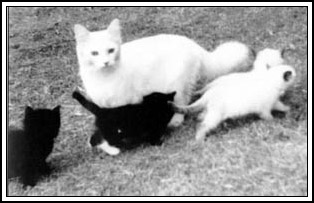
Stand in for
Josephine with the first Ragdoll kittens, Summer 1965,
Left
to right : Gueber, Mitts, Tiki and Kyoto
Josephine was run over by a
car and left lying
by the side of the road for a couple of days.
Eventually she was taken to the local university for treatment.
Ann
firmly believed that during her time at the university,
Josephine was
"genetically manipulated", resulting in future
kittens being loving,
relaxed, "floppy" and unable to feel pain.
Today, this belief in
Josephine's genetic manipulation is
rejected as a fallacy as the Ragdoll
experiences pain in the same
way as any other breed of cat.
As far
as the "floppiness" is concerned, kittens and cats
from any breed could
present this trait - it is not caused
by any genetic characteristic, but
rather
by the way in which the kitten is raised and socialised.
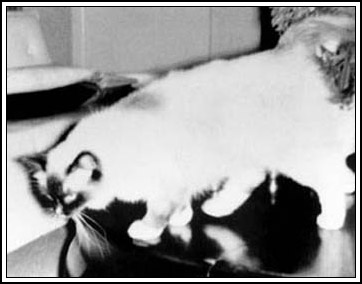
Raggedy Ann
Daddy Warbucks
The first Mitted Ragdoll, and the father of the "Ragdoll
look"
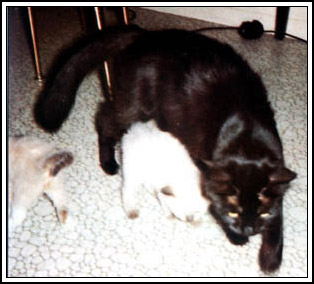
Buckwheat with
her kittens, Kyoto and Tiki
Ann acquired three of
Josephine's half-related kittens from
her neighbour – Pretty Boy, "a cat
with the appearance
of the Sacred Cat of Burma" (The Birman
breed) which
Ann later called Daddy Warbucks; Buckwheat
(a black
non-pointed female);
and Fugianna (a badly marked Bicolour female).
These
three cats became the founding Ragdolls,
producing the first Ragdoll
kittens. In the summer of 1965,
a litter of four kittens were born
- two
pointed and two non-pointed kittens.
Ann ruled the Ragdoll
breeding programme with
a strict hand, registering and patenting the name
Ragdoll and franchising out future breeding stock under strict
contracts.
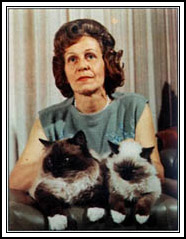
Ann Baker with
Kyoto and Kookie Tu
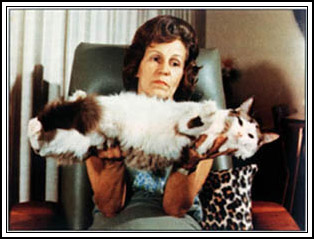
Ann holding
Fugianna
Remaining protective over her
kittens, Josephine fought
with the family dog. It is alleged that Mr
Baker, who had
had enough of Josephine's protectiveness, had Josephine
and
her kittens destroyed, thereby ending the life of the
founding queen of
the Ragdoll breed.
Ann Baker passed away in 1997.
During mid-1997 the first
Ragdolls were imported to South Africa,
and in November 1999 the Ragdoll
breed achieved full
championship status in the South African show
halls.
Early 2000 the non-pointed Ragdoll was granted full
championship status in South Africa.
Raglin Ragdolls produced the
first Ragdoll to qualify for,
and compete in, the
prestigious annual Cat of The Year competition.
Read more about SP
PM Raglin's Mille Miglia on the Gallery :
Colourpoint web
pages.
(Some information and all
pictures above from "The Definitive Guide
to Ragdolls" by
Lorna
Wallace, Robin Pickering & David Pollard)

CHARACTERISTICS OF THE
RAGDOLL
Temperament
Ragdolls have amiable
temperaments. Although they differ individually,
they are gentle
and quiet cats. They enjoy human companionship
although
some individuals might enjoy sitting next to you, rather than in
your lap.
They also enjoy the company of
other pets, including dogs.
Due to Ragdolls
being trusting, they should never ever be allowed
to roam
the
neighbourhood where they could get into harm's way.
Gentle
Giants
The ideal Ragdoll is a large,
imposing, strongly built cat with an elongated body,
moderately long legs
and plumed tail in proportion to the body.
They may also have a fat pad
(Greater Omentum) on the lower abdomen.
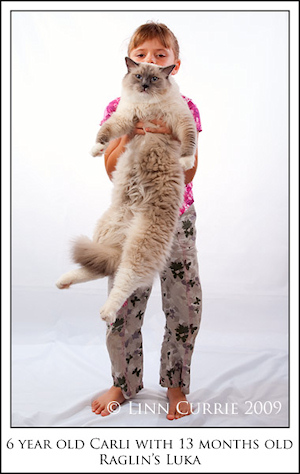 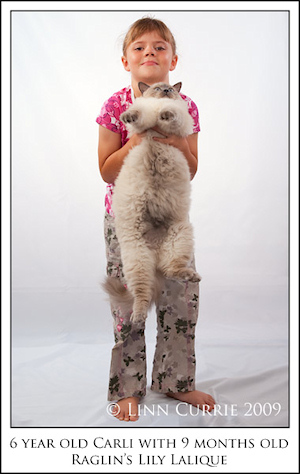
Neutered males could grow into
gentle giants weighing more than 10 kg
but the norm seems to be around 7
kg. Spayed females could weigh up
to
about 7kg but in general
they are around 5 kg. Ragdolls mature slowly and
do not reach
maturity until they are approximately four years
old.
Point colouring could take up to three years to
develop.
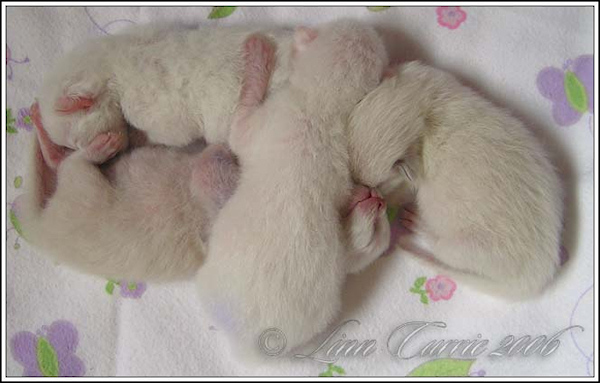
Ragdolls are
born without colour. They are not white, they are not beige.
The term "whiter shade of pale" is most applicable for newborn pointed
kittens.
Within about 12 hours, the first sign of colour is visible
on the ears.
By day three colour is visible on nose
leather.
Newborn Ragdoll
kittens showing colour and pattern
are Mink or Sepia
and not
accepted in South Africa. Those kittens may not be registered
nor shown.
Note :
The purple markings you see on the kittens above are our way of
identifying
newborn kittens
for weight record keeping purposes. We use Gentian Violet
in order to tell kittens apart at this
age
Patterns
Pointed Ragdolls come in three
different patterns:
-
Colourpoint – Dark mask, ears, legs &
tail; no white whatsoever allowed
-
Mitted – Dark mask, ears and tail; white
mittens on front feet and white hind legs
-
Bicolour – Dark ears &
tail; white legs; inverted "V" on the face
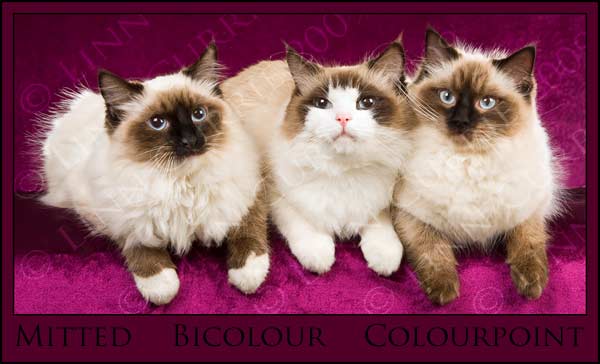 From L to R : BoomBoom, Lori & Bailey
From L to R : BoomBoom, Lori & Bailey
|
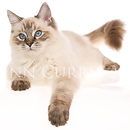 |
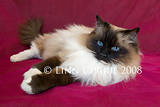
|
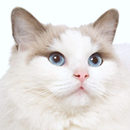 |
|
Seal
Tabby Colourpoint |
Seal
Mitted |
Blue
Bicolour |
Colours
Pointed Ragdolls come in six
different colours:
- Seal – Points are deep seal brown
- Blue – Points are slate blue
- Chocolate – Points are milk chocolate in
colour (not available in South Africa)
- Lilac – Points are frosty grey (not
available in South Africa)
- Flame - Points are deep orange flame to
deep red
- Cream - Points are buff cream to apricot
in colour
|
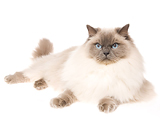 |
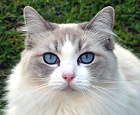 |
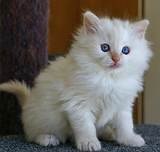 |
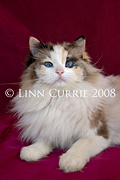 |
|
Blue
Colourpoint |
Blue Tabby
Bicolour |
Cream
Mitted |
Seal
Tortie
Mitted |
Non-Pointed
Ragdolls
Non-pointed Ragdolls come in
the Bicolour and Mitted patterns, as well
as the solid
(self-coloured) cat.
These cats are purebred and
registered Ragdolls,
descending from the foundation cats.
At present there are no purebred,
registered non-pointed Ragdolls
being bred with in South Africa.
The Ragdoll
Coat
Ragdolls have a soft, medium
length coat which sheds just like any other cat breed.
Regular grooming assists in removing loose, dead hair and prevents
hairballs and mats.
Grooming is a wonderful one-on-one
communication
and bonding experience for both owner and
pet.

Taking Care of your
Ragdoll
When looking at overseas
Ragdoll websites, one is reminded that the Ragdoll
is a strictly indoor
breed. That is because they are kept indoors
(all windows and
doors shut) ... not because they have a gene that
will prevent them from
going outside the house.
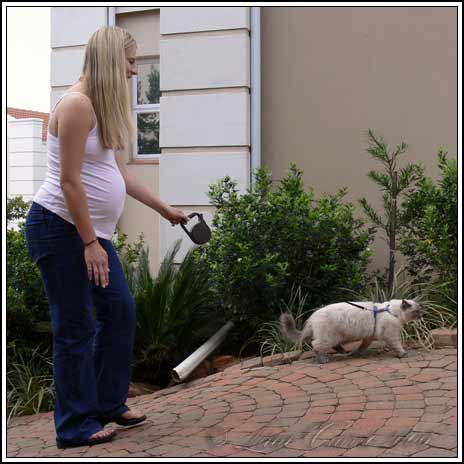
If you choose to have a strictly indoor Ragdoll pet,
they can
be taught
to walk on a body harness.
Here's 8 month old Carlos
taking his mom for a brisk walk!

All cats love to be outdoors
and there is no harm
in letting them do so
- on condition that they
are confined
to a cat escape-proof and extremely safe outdoor
area.
Johannesburg based company "D's Fencing
& Security" specialises
in electrified
pet fencing and one of my
kitten owners found them
to be very reliable and fairly priced.
You
can view their website for
contact details and more information at http://www.dsfencing.co.za/
Disclaimer : Raglin Ragdolls is not
associated with this company; we do not
earn
commission on referrals; and
if you decide to appoint them
for a contract we are
not to be held
responsible in case of any disputes.

Alf and Diana made this very beautiful, safe and
interesting
safety enclosure for their new kitten, Darwin.
This is not where their kitten lives - this enclosure is only there for
his
playtime in the garden during the day, and probably during hot Summer
evenings
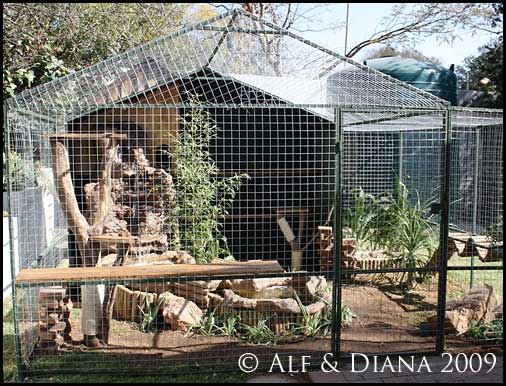

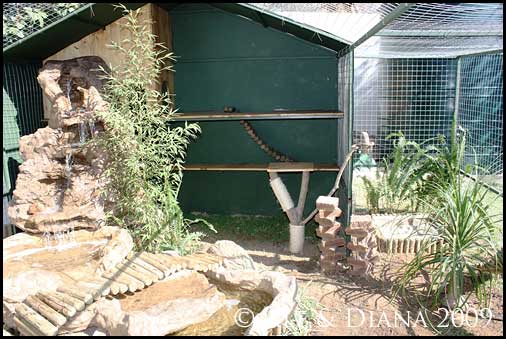
Look under the solid roof - there Darwin has a safe enclosed "house"
where he can go hide and sleep, if he wants to.
This enclosure has a beautiful water feature, shelves, tree branches ...
a lot of fun for any cat ... Darwin is one very lucky boy!
Below : an interesting wooden walk-way for an energetic Ragdoll
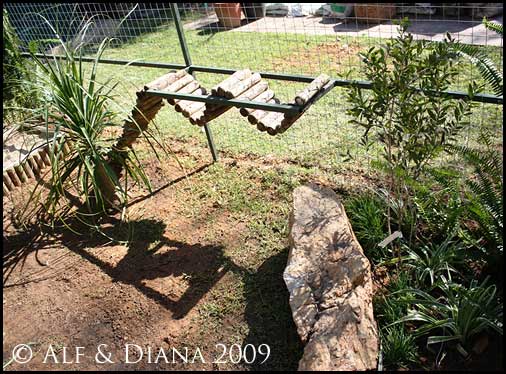

Raglin Ragdoll kitten owners
Mike & Gail built this beautiful
"cat house" themselves.
Below are photographs which will
inspire you to make a safe enclosure
for your own kitten/cat
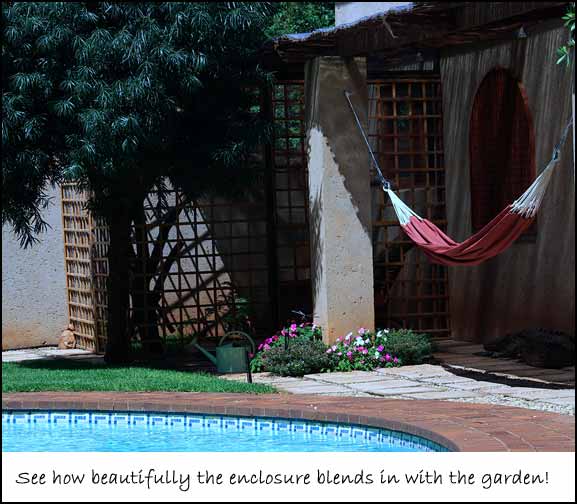

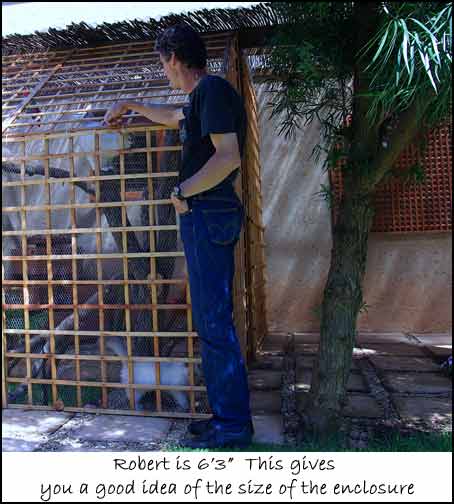
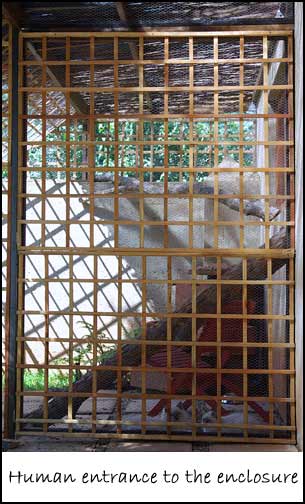
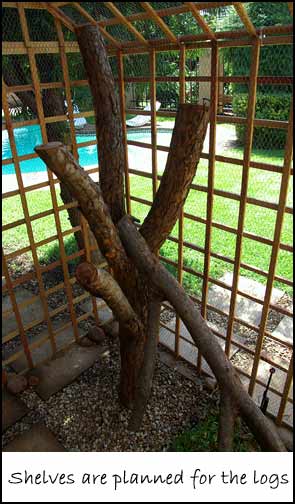

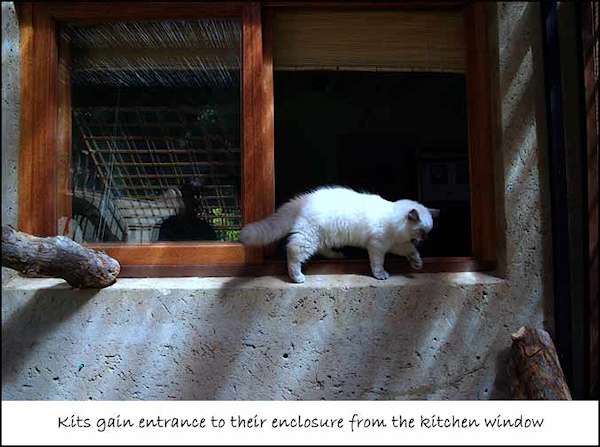
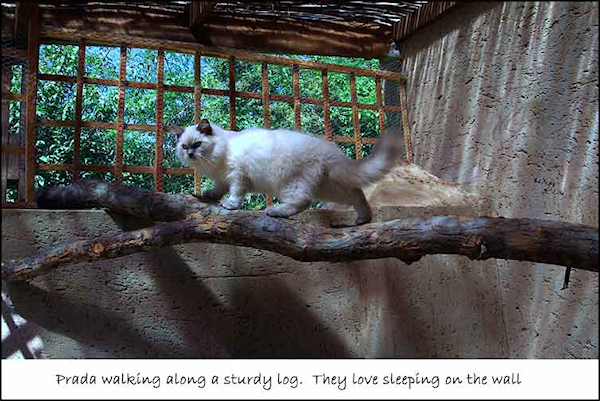


Geoff
& Annie Hall in George had a special outdoor cage built for their
Ragdolls.
This cage is attached to the outside wall and can be
dismantled
and removed,
should they so wish.
The cage also has
an outdoor gate which makes gardening easy
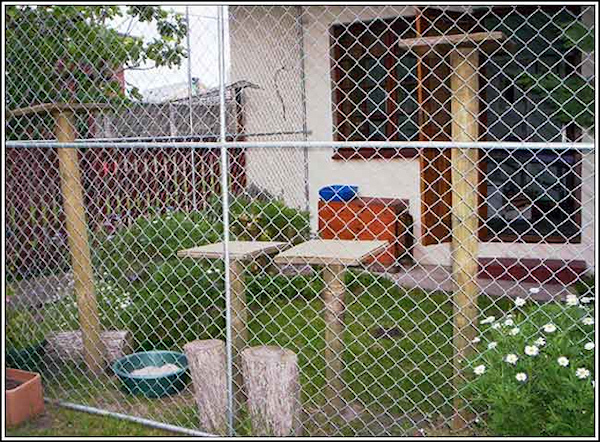
Outdoor scratch posts, wooden logs,
lovely lawn and cat-safe plants
and shrubs make this a very safe and
aesthetically pleasing place for the cats to play
To
prevent their Ragdolls from jumping over walls,
they constructed this
easy-to-make cat-fence
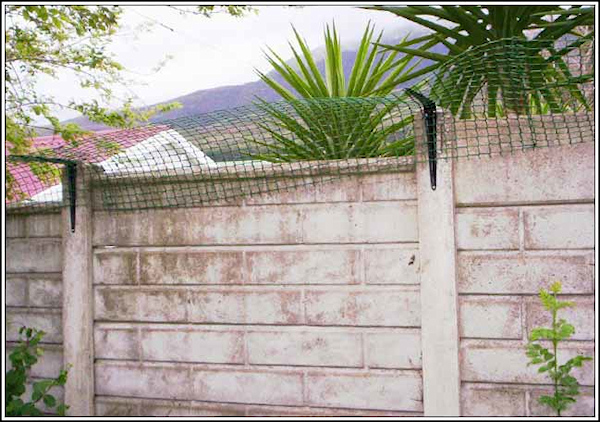
To prevent
their Ragdolls from climbing this tree,
they attached an "umbrella" of
mesh around the trunk
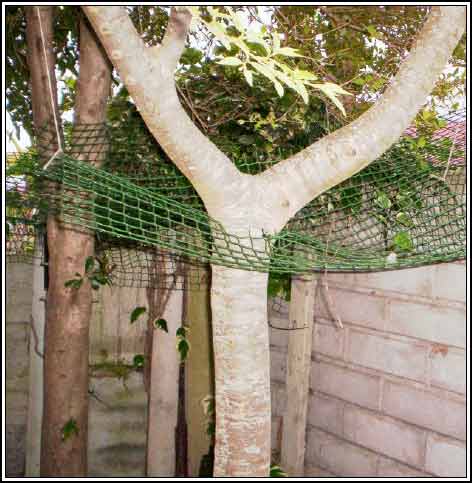
My sincerest thanks to Geoff &
Annie for the above photographs

A friend's Maine Coon
went missing and that spurred him on to investigate
some kind of tracking
device for pets. Such a product is being launched in
South Africa
and you can read more about at http://www.ptrack.co.za
Weight and size can be found on the FAQ
page. This device is also suitable to track children.
Disclaimer : Please note that I am not associated with this company
or
product and do not earn commission on any sales. Please do not contact me for sales or enquiries.
Ragdolls don’t
need any special treatment. High-quality premium foods and
healthy treats,
fresh water, a secure and loving home, de-worming, annual booster vaccinations
and an annual vet check are all that are
needed to maintain their health.

Ragdolls are
easily trained and can be taught to come on command, fetch and do
tricks.
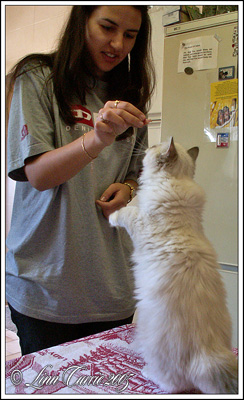
Michelle
taught 15 week old Jessie to "beg" in only one day!
A Ragdoll should
never be dangled like a toy rag doll.
Always pick up a kitten or lift a cat by supporting it with
one hand
under the armpits and the other hand under the
buttocks.
Never pick up a kitten
or cat by the scruff ... only queens
know how to do it without
hurting their kittens.

Here's Robert
holding ChiChi in a safe and comfortable cradle
position
On a Personal
Note:
I am often asked exactly what attracted me to the Ragdoll breed.
It
is quite easy ...
There is nothing extreme about the Ragdoll.
The "overall package" of the Ragdoll is pleasing to the eye.
The
ideal Ragdoll should be large, friendly, soft-spoken,
inquisitive (yet not adventurous) cat - always ready to "lend a
helping hand".
They will greet visitors, head-butt
for massages, walk around showing
off their plumed tails and
flop down at your feet.
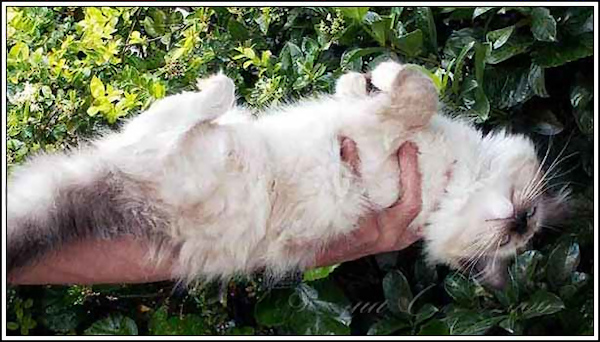
Some lines
produce kittens that are very relaxed when held, like ChiChi above
in a
"Ragdoll Flop".
However, there isn't a "flop gene" in the
Ragdoll that makes them go limp
At Raglin Ragdolls, our aim is to only breed with
lines that produce kittens
with the above personality
traits;
as well as only work with healthy
lines that produce kittens with strong immunities
and healthy systems.

Here's what
Ragdoll owners have to say about this special breed :
We have been owned by Ragdolls
since end 2001 ~ was there life before
Ragdoll cats we often ask
ourselves?
Monty and Kashka (aka Chicken,
Baby, Button and a host of other
kitchee-coo names) are half brothers
sharing the same dad and they
arrived with us on a Christmas morning aged
just over 3 months.
One Blue Mitted Lynx and one Seal Mitted bundle of
soft,
creamy fur with enormous blue eyes.
Our hearts were theirs from
the
first instance. And our bed, morning newspaper, couch, chairs as
well as
any
empty box or plastic packet!
Slowly but surely they
re-arranged the entire house to suit themselves
and their agenda. Monty
slept in the guest
room until noon while Kashka
found that alternating
between my in-tray and my t-shirt shelf suited him better.
Their favourite
time of day is late afternoon when Da returns from
work and Mom is home
and thinking about supper.
Then they go
for walks in and around the garden
with us, chase leaves or bugs
and play hide-and-seek with
each other in
the bushes.
Suddenly they remember they are adults and cats after all and
preen and wash,
look aloof and think about sleeping off their supper.
They sleep. Goodness how they
sleep! After a good night’s rest they are
exhausted and so move to their ‘flavour of the month’ day time place and
sleep some more. In winter they
will sleep like real cats, all curled up
neatly with paws tucked under and
noses covered by tail.
But in summer they fly the Ragdoll colours! Whether
on
the floor, the couch or
a chair they sleep either on their backs with
legs akimbo or drape
themselves over the back
of a sofa like a floppy soft
toy.
We always thought our previous
feline owners were large cats
until the Raggies arrived and grew . . . .
and grew . . . . . and grew.
I think they have stopped now and
fluctuations are only between winter coats with
heavy ruffs and slinkier
summer attire. They don’t so much run as lope across
the lawn, their
lion-like bellies swaying.
But they would rather walk than run any
time.
They are placid, predictable,
affectionate (on their terms), cuddlers
and not fighters, homebodies and
not wanderers.
Their voices, like their coats, are rabbit soft. They are
vocal at suppertime,
sometimes when spoken to and when they
want the water
fountain turned on.
They prrrrrrrrt greetings when we return home and
first thing in the morning
but are never loud and never yowl.
Last week we had four new
visitors from overseas to our home.
They spent more time on the carpet
scratching
offered tummies, stroking floppy,
draped backs and taking
photographs than eating their braai.
Our hearts and homes would be
empty without them.
Penni Warncke,
February 2006

I, like
other "cat people" consider myself born a "cat person".
I have been
so enriched by all the
whiskered friends I have met on my
life
journey. I have truly felt every moment of time spent with
"my furry
children"
to have been so precious.
Last
year, to my great joy and delight I "found" the Ragdoll breed.
In
the words
of my vet "they are the most
phenomenal animals".
I have
encountered some of the characteristics I list here in all of
my "kitty
kids"
but my two Ragdoll's have displayed
ALL of these
characteristics. Large, muscular, talkative, relaxed,
intelligent,
gentle, exceptionally affectionate, responsive, healthy,
bright eyed
and
bushy tailed, playful, companionable, friendly,
beautiful, luxurious,
inquisitive, always ready for a game.
They
truly are the most magnificent friends one could ever wish
for.
Annie
Hall, February 2006

Cats have owned me my entire life, and in 2000 two
Ragdoll brothers
came into my life,
Pie a Seal Mitted and Skye a Blue
solid.
Like many potential owners, prior to deciding on
Ragdolls
I researched the breed and found they were commonly
described
as
large cats with medium length fur and gentle temperaments.
What a bland description for an
amazing breed. Don’t be
misled,
Ragdolls have all those lovable mischievous qualities that make
us
admire and adore cats and then that intangible something extra.
Although there are certain breed specifications with
which they should
conform, each is a unique character. Pie is outgoing and adventuresome
and somehow always seems to land up in trouble.
If it rains he will be caught in
it,
coming in with his fur standing on end,
his tree climbing activities
tend to result in him getting stuck and needing
rescuing and he is always
on the wrong side of a closed door.
Skye however prefers his home comforts
and even when venturing
outside prefers to stay close to the door and his humans.
He is happiest lying on a chair or
table next to his humans.
Pie
too loves to know his humans are close
but doesn’t believe in being
as
demonstrative about it. When
you are busy in a room
he will be
found sleeping
on the windowsill, move
to a new room and you soon
find he has followed you and dozing where he
can
keep an eye on you.
Doors
must be left open so he can patrol his territory,
checking on the humans
(even during the night).
Ragdolls are very intelligent and are experienced human
trainers.
Pie informs us long
before he gets
to the door that he wants to
come in and has trained us to
wait with the door open whilst
he comes ambling up the steps. It is quite likely at this point
that he will
tell you he needs a rest from all that exertion and flops
over onto his
back
exposing his tummy for a rub. Tummy rubs are one of his
favourite activities and he will find every opportunity
to lie in your
way
so you have to bend over and give him attention.
Ragdolls like to talk,
but don’t see the need
to raise their voices unless
all other means of
communication have failed.
Both boys greet us with
soft chirrups,
when they come into a
room. Skye extends this
courtesy to his doggy friends and can often be found rubbing up
against
the dogs’ faces in greeting (much to the dogs’ embarrassment)
and sneaking
out of the house through a dog’s legs.
Despite their bulk Ragdolls are incredibly gentle, and
are more likely
to restrain your hand with a large fluffy paw
rather than
first
resorting
to using claws.
Their large paws are a wonderful feature of the breed, when
you
feel like
you need a bit of comfort; just holding a huge paw
makes you
feel much better. My Ragdolls
love their cuddles;
Skye loves to be picked up, folding himself to fit
snugly into your arms.
Pie
finds the feet off ground thing a bit off-putting, preferring you to be
seated
for a Rag cuddle. If
you get too preoccupied to do the cuddle thing,
a quick furry head but is
used to get your attention.
Ragdolls are the gentle
giants of the cat world and are loving,
companions who thrive on human
attention.
If you are looking
for the stereotypical cat, the one you only see
at mealtimes then don’t
even consider a Ragdoll.
A
Ragdoll is a partner, a friend, a family member, a very human soul
wrapped
in a large furry cat form and yes I am
their very willing
slave.
Ruth
Hine, February 2006

Word of caution … Ragdolls
are addictive!
|